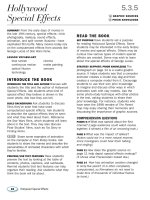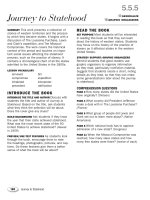4 5 22 mill girls (social studies)
Bạn đang xem bản rút gọn của tài liệu. Xem và tải ngay bản đầy đủ của tài liệu tại đây (5.79 MB, 18 trang )
Mill
Girls
by Anne Kasper
H O UG H T O N MIF F L IN
Mill
Girls
by Anne Kasper
ILLUSTRATION CREDIT: Len Ebert
PHOTOGRAPHY CREDITS: Cover © Bettmann/Corbis; Cover, 3–14 (border) © Getty Images; tp, 3–5 © Bettmann/Corbis;
5 © Library of Congress, Prints & Photographs Division, National Child Labor Committee Collection,; 7–8 © Bettmann/
Corbis; 11 © Underwood & Underwood/Corbis; 13 13 © Polka Dot Images/SuperStock; 14 © Bob Sciarrino/Star Ledger/
Corbis.
Copyright © by Houghton Mifflin Harcourt Publishing Company
All rights reserved. No part of this work may be reproduced or transmitted in any form or by any means, electronic or
mechanical, including photocopying or recording, or by any information storage and retrieval system, without the prior
written permission of the copyright owner unless such copying is expressly permitted by federal copyright law. Requests
for permission to make copies of any part of the work should be addressed to Houghton Mifflin Harcourt School Publishers,
Attn: Permissions, 6277 Sea Harbor Drive, Orlando, Florida 32887-6777.
Printed in China
ISBN-13: 978-0-547-02330-4
ISBN-10: 0-547-02330-8
1 2 3 4 5 6 7 8 0940 18 17 16 15 14 13 12 11
If you have received these materials as examination copies free of charge, Houghton Mifflin Harcourt School Publishers
retains title to the materials and they may not be resold. Resale of examination copies is strictly prohibited.
Possession of this publication in print format does not entitle users to convert this publication, or any portion of it, into
electronic format.
Table of Contents
Moving to the City
3
Life on the Farm
4
A New Life
5
Jobs at the Mill
6
A Day in the Life
7
Opening Doors
8
On Strike
9
Speaking Out
10
Women’s Suffrage Movement
11
Creating Change
13
Important Dates in Women’s History
14
Moving to the City
In the early 1800s, thousands of young
women in New England left their farm homes.
They moved to cities to find work in America’s
first textile mills. These mills made woven cloth
from cotton that was spun into thread. Moving
to the city was a big change for these women.
Textile mills were large and noisy factories. Early textile
mills were run by waterpower.
3
Life on the Farm
Before textile mills and other factories were
built in New England, most women worked
on their family’s farm. Life on the farm was
hard work. Women had to cook, clean, care for
children, and help raise crops. Many also made
their own clothing, soap, and candles.
Women used to spin
their own thread.
4
Many workers spent their first earnings on new clothes.
A New Life
The opportunity to work in the textile
mills provided women with a chance to live
on their own and earn their own money for
the first time in their lives. In the 1830s and
1840s, these young “mill girls” worked in New
England textile mills. They often lived in
boardinghouses owned by the factories.
5
Jobs at the Mill
The women had different duties at the mill.
Some workers watched over spinning machines
that spun cotton into thread. Others collected
full bobbins of thread and carried them to the
looms. There, weavers operated giant looms
that turned thread into cloth.
Bobbin
Loom
A loom was a machine used in textile mills to weave
cloth. The bobbin was a part that held thread.
6
Working in a mill meant that women were on their feet
for hours.
A Day in the Life
Imagine working at a textile mill in the
1840s. Your day begins at five o’clock in the
morning. Inside the mill, it is hot and noisy,
and the air is filled with lint. The machinery is
dangerous. You might stand at a loom and tie
broken threads again and again. After twelve
hours, your shift ends, and it’s time to go home.
You are exhausted.
7
Opening Doors
Although the work was exhausting, the
textile mills changed the lives of the mill girls.
Many workers spent their free time reading
and attending lectures or talks. This showed
the country that women were both intelligent
and informed. Some workers even saved their
money to become some of the first women to
attend college.
Mill workers in Lowell,
Massachusetts,
published their own
magazine.
8
On Strike
As time passed, mill workers’ lives became
more difficult. Women worked longer hours
and earned less pay. The factories also were
dangerous. Some workers were injured when
their arms or hands were caught in machines.
In many cases, the mill owners denied that
anything was wrong.
To fight back, factory women began to
organize strikes called turn-outs. Some were
well organized, while others were disorderly.
The first turn-out occurred in Rhode Island,
in 1824, when several mills announced that
workers would have to work longer hours.
9
Speaking Out
As mill workers learned about politics, they
took their protests to the next level. In the 1840s,
women could not vote, so they began sending
petitions to the Massachusetts legislature asking
for an amendment to make a ten-hour workday
the longest amount of time a person could
work. The law wasn’t changed, but the women
succeeded in getting their voices heard.
In the 1840s, women
working at mills in Lowell,
Massachusetts, formed a
group to protest low pay
and poor conditions. This
group, led by a woman
named Sarah Bagley,
became the first official
group of women to work
together to fight for better
conditions and higher pay.
10
Women’s Suffrage Movement
Because women did not have the right to
vote, mill workers did not get to approve the
candidates who made the laws that affected
them. For this reason, many joined the women’s
suffrage movement, a group that fought for the
women’s right to go to the polls and vote.
Women in the United States finally won the right to
vote in 1920.
11
How Women’s Work Has Changed
Before the Rise of
Factories and Mills
After the Rise of
Factories and Mills
Today
housewife
factory worker
doctor
child caring
telephone operator
lawyer
schoolteacher
nurse
politician
servant
secretary
journalist
schoolteacher
firefighter
police officer
engineer
accountant
stockbroker
FBI agent
professor
archaeologist
astronaut
much, much more
12
Creating Change
The story of New England’s female textile
workers shows how a small group can change
the country. Throughout American history,
people have fought for change. Harriet Tubman
led enslaved workers to freedom on the
Underground Railroad, and Dr. Martin Luther
King, Jr. led the civil rights movement. Maybe
one day you will change the world, too!
Today, women in the United States can pursue any
career they choose.
13
Important Dates in Women’s History
1793 — America’s first water-powered textile mill opens. It was
built in Rhode Island by Samuel Slater.
1822 — First planned textile city developed in Lowell,
Massachusetts.
1824 — First turn-out held by textile workers.
1844 — Textile workers begin petitioning the Massachusetts
legislature for ten-hour workdays.
1869 — The National Women’s Suffrage Association formed to
fight for women’s right to vote.
1920 — The Nineteenth Amendment gives women the right to
vote in the United States.
Nowadays, women not
only vote, they can be
mayors, governors, and
much more.
14
Responding
Word Builder The
word informed means “in the know.” What
things do people use to stay informed?
What things do they use for entertainment?
What things can both inform and entertain?
TARGET VOCABULARY
Things Used to
Stay Informed
Weather
report
Both
Things Used to
Be Entertained
Newspaper
Movies
?
?
?
Write About It
Text to Self The mill girls felt strongly about
getting their voices heard. Write a paragraph
in which you describe something that you feel
very strongly about. Use two words from the
Word Builder in your writing.
15
TARGET VOCABULARY
amendment
approve
candidates
denied
disorderly
informed
intelligent
legislature
politics
polls
Infer/Predict Use text clues to
figure out what isn’t directly stated by the author.
TARGET STRATEGY
What vocabulary word rhymes with something that woodpeckers make in trees?
16
Level: S
DRA: 40
Social Studies
Strategy:
Infer/Predict
Word Count: 884
4.5.22 Build Vocabulary
HOUGHTON MIFFLIN
Online Leveled Books
ISBN-13:978-0-547-02330-4
ISBN-10:0-547-02330-8
1032229









